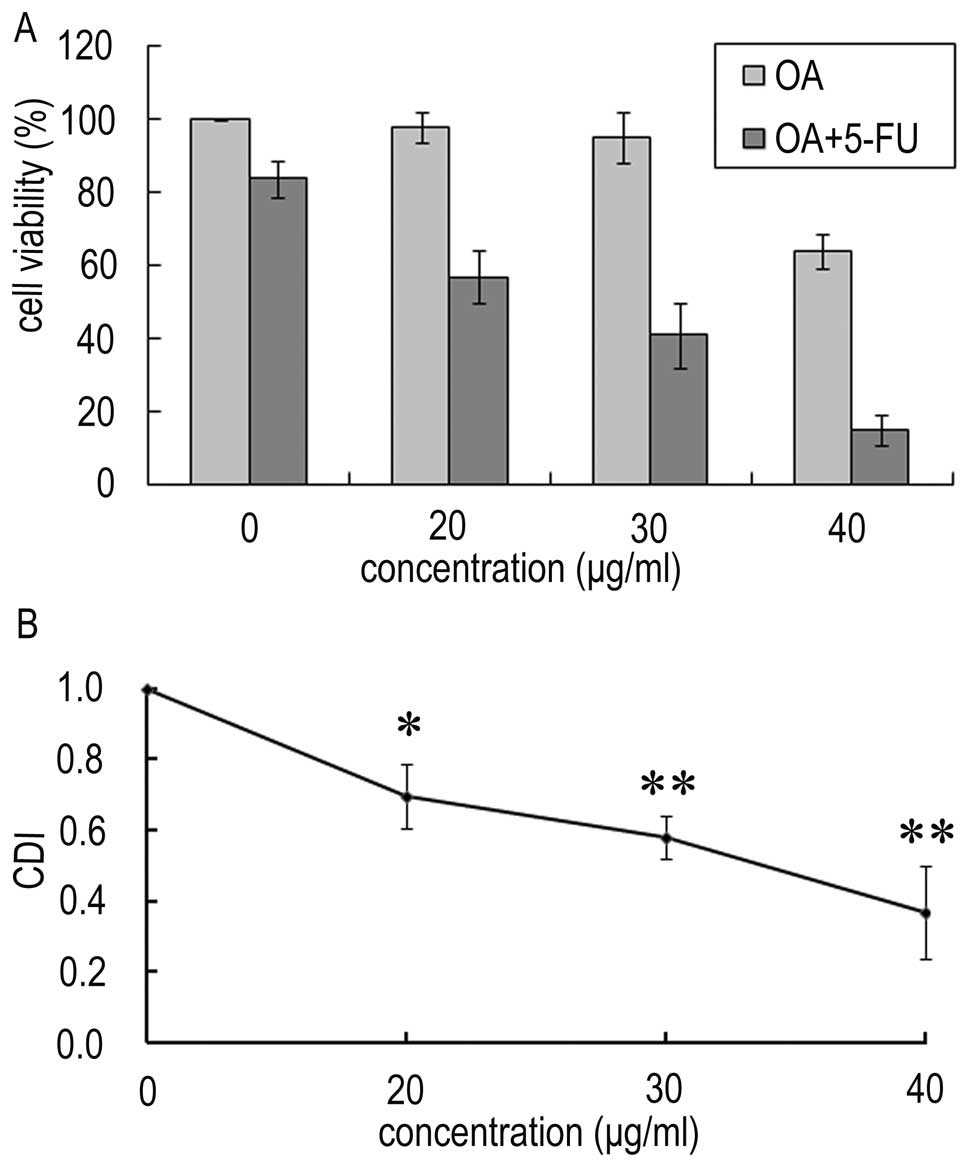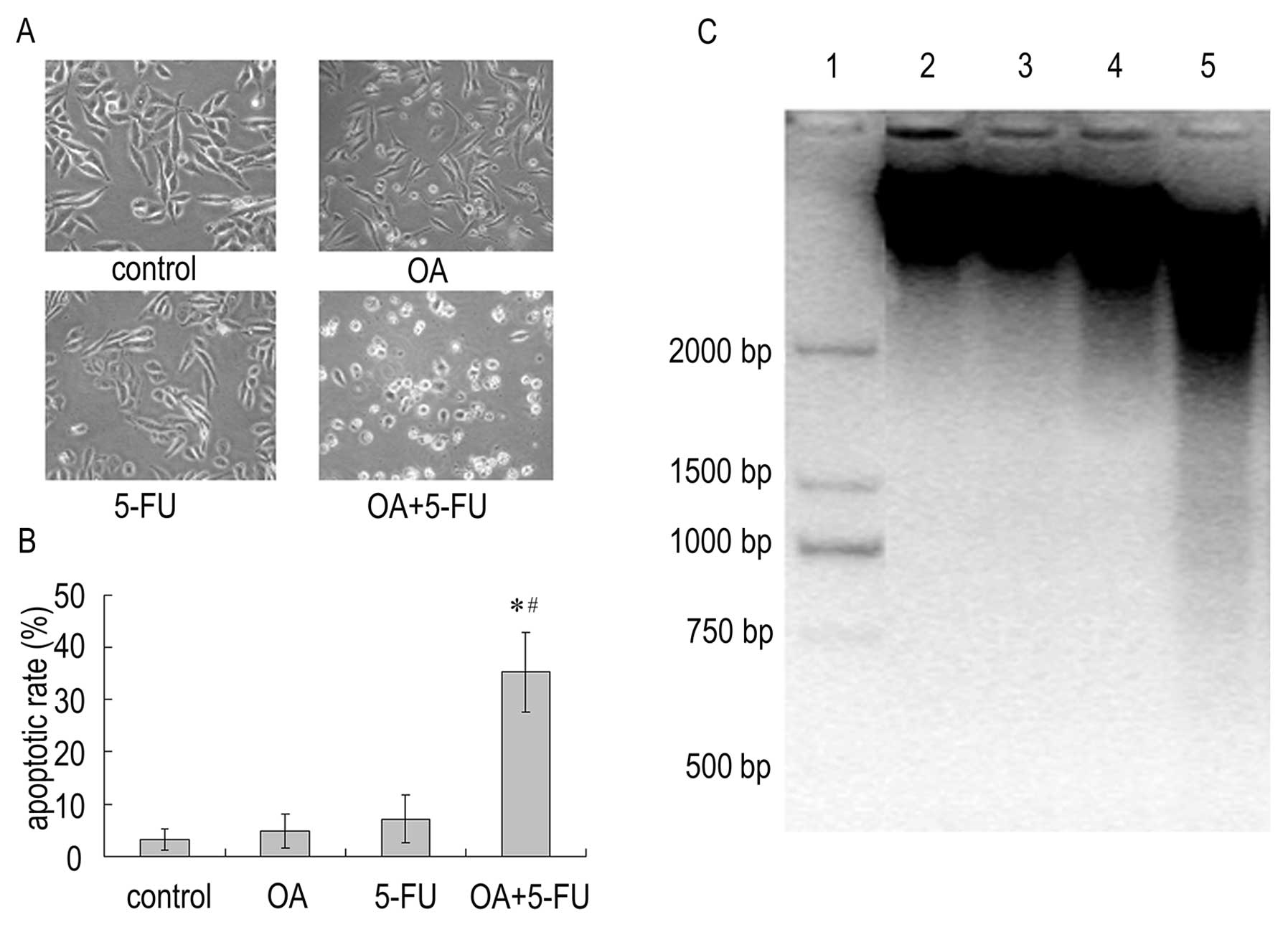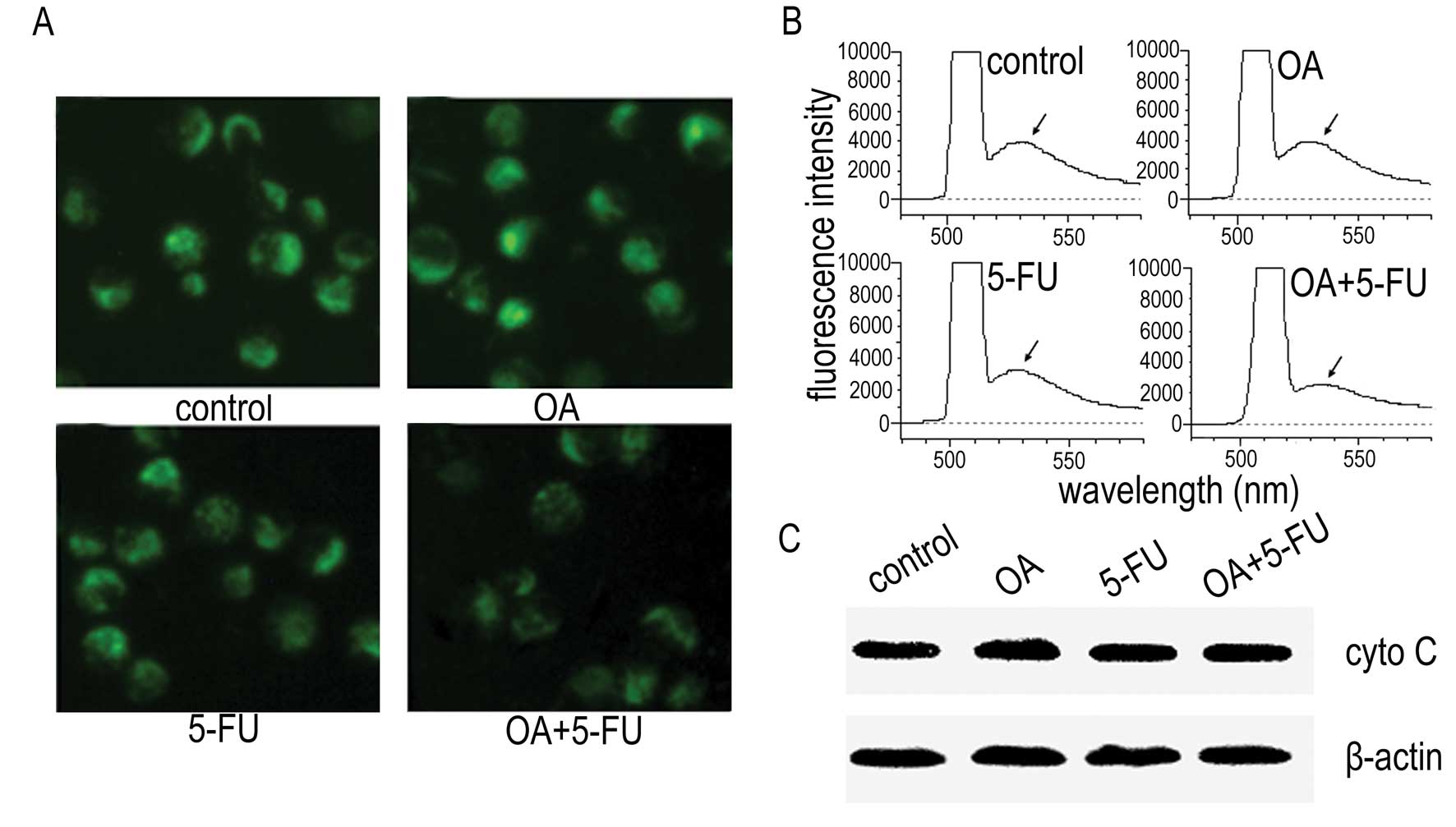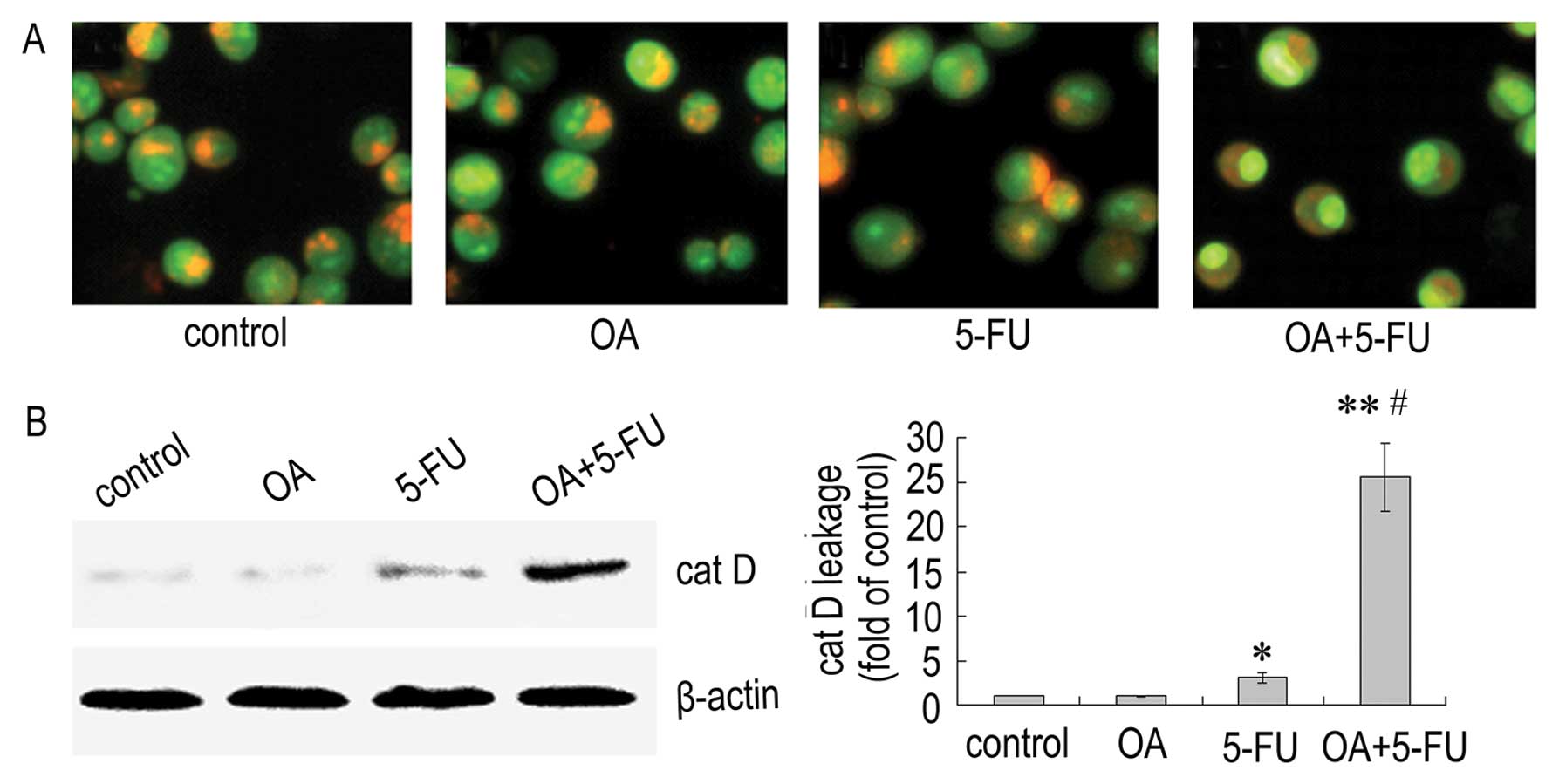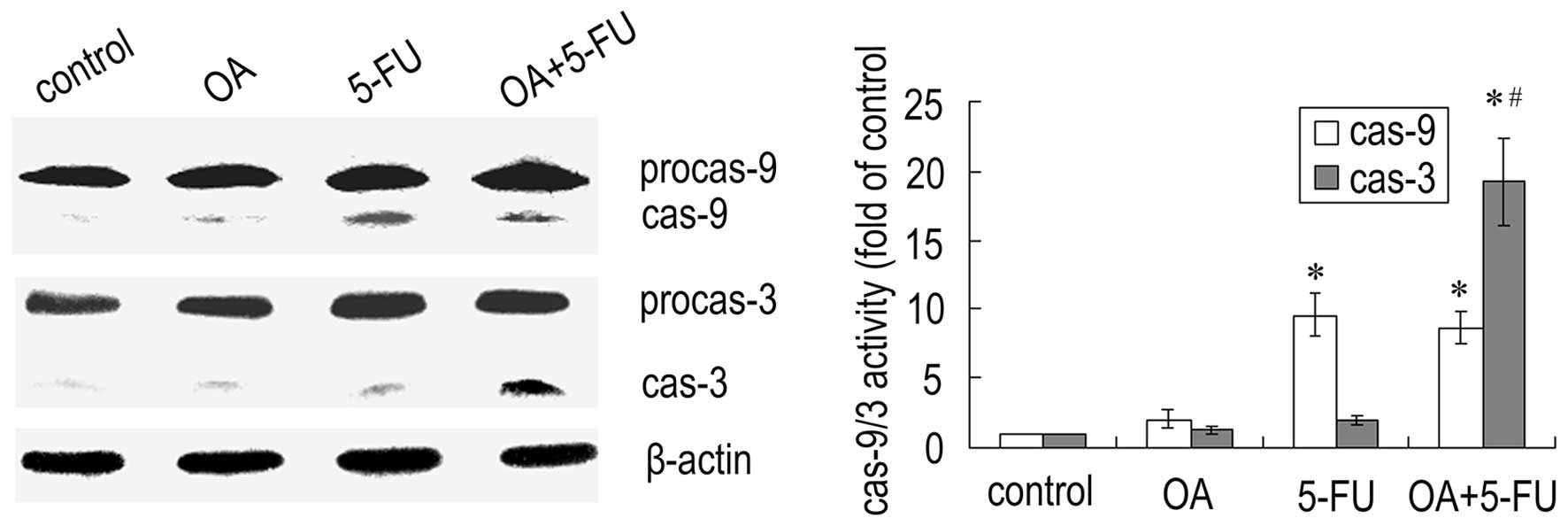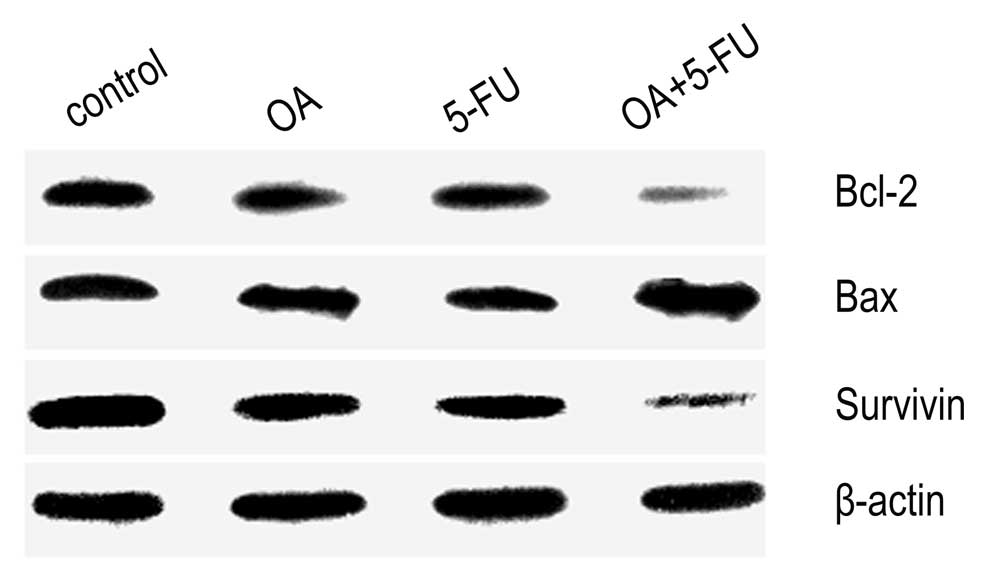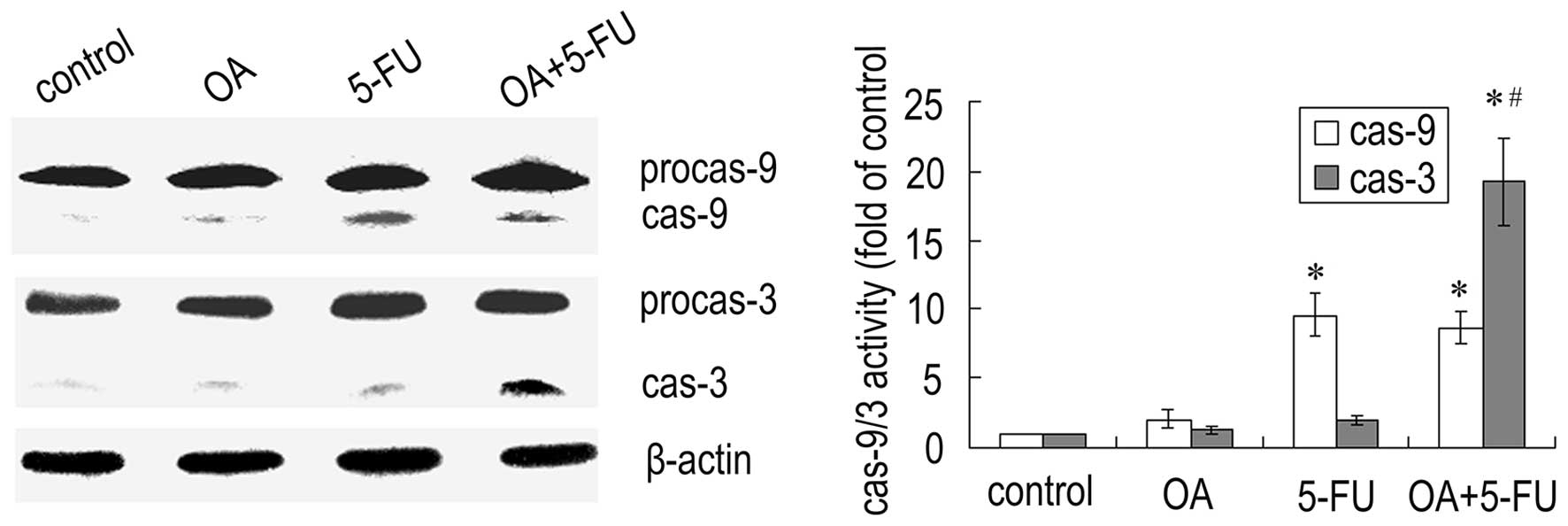Oleanolic acid potentiates the antitumor activity of 5-fluorouracil in pancreatic cancer cells
- Authors:
- Published online on: July 19, 2012 https://doi.org/10.3892/or.2012.1921
- Pages: 1339-1345
Abstract
Introduction
Pancreatic cancer is the fourth leading cause of cancer death in the United States, with an estimated 43,140 new cases and 36,800 deaths in 2010 (1). Patients diagnosed with pancreatic cancer typically have a poor prognosis due to lack of early diagnostic symptoms and effective treatments (2,3). Therefore, efforts to treat pancreatic cancer have been directed towards developing alternative modalities of therapy.
5-fluorouracil (5-FU), as a chemotherapy agent, is widely used for the treatment of solid tumors such as pancreatic cancer. It can also induce apoptosis in some sensitive cancer cell lines by blocking the activity of thymidylate synthase (4). However, 5-FU presents the disappointing chemotherapeutic effectiveness due to side effects and multiple drug resistance (5,6). Attempts to solve these problems have taken various approaches, including the combined use of cancer drugs. It is recently shown that combined treatment with various anticancer drugs increases the efficiency and reduces the cytotoxicity of some cancer drugs (7–12).
Natural products have been a successful source of therapeutic agents and drug leads. Oleanolic acid (OA) belongs to the group of pentacyclic triterpenes, which is widely distributed in fruits and some medicinal herbs (13). It has been reported that OA has antioxidant (14), antiinflammatory (15), antidiabetic (16), antimutagenicity (17) and antitumor (18) properties. Recently, the antitumor activity of OA has attracted more attention due to its marked antitumor effects and pharmacological safety. Our recent study reveals that OA induces cell death significantly via ROS-mediated mitochondrial pathway in human Panc-28 cells (19). However, the combined effects of OA and 5-FU in inhibiting cancer cell proliferation and inducing apoptosis have not been investigated.
In the present study, the effects of OA combined with 5-FU on cellular proliferation and apoptosis in human pancreatic cancer Panc-28 cells were studied and the underlined mechanism is also presented.
Materials and methods
Materials
Antibodies against caspase-3, -9, Bcl-2, Bax, survivin, cytochrome C, cathepsin D, p53 and NF-κB were purchased from Santa Cruz Biotechnology, Inc. Anti-mouse or anti-rabbit antibodies were purchased from Beijing Solarbio Science & Technology Co., Ltd.
Cell line and cell culture
Panc-28, a human pancreatic cancer cell line, was cultured in DMEM/F12 supplemented with 10% FBS plus antibiotics of penicillin and streptomycin (Sigma) at 37°C in 5% CO2 in air. Cells were grown in 96-, 24- and 6-well plates.
Oleanolic acid and 5-fluorouracil treatment
OA (Sigma) and 5-FU (Sigma) were dissolved in dimethylsulfoxide (DMSO). Cells were pretreated with OA for 12 h. Then, the supernatant fluid containing OA was removed and the fresh medium containing 5-FU was added, and were incubated at 37°C for another 24 h and harvested for the following examinations.
MTT assay
Inhibition of cell proliferation by OA was measured by MTT assay (20). Briefly, cells were grown in a 96-well plate (5×103/200 μl/well) overnight, and were treated with OA (20, 30 and 40 μg/ml) for 12 h, and then the supernatant fluid was removed. The fresh medium with 5-FU (10 μg/ml) was added. After incubation for another 24 h, 40 μl of MTT solution (5 mg/ml) was added to each well. After incubation for additional 4 h, the formazan precipitate was dissolved in 150 μl DMSO, and then the absorbance at 490 nm was measured using ELx808™ Absorbance Microplate Reader (BioTek, USA). The nature of the interactions between studied drugs was estimated by using published methods (21,22), based on the principles described by Chou and Talalay (23,24). Briefly, the expected value of combination effect between treatment with OA and treatment with 5-FU is calculated by the following formula: [(observed treatment with OA value)/(control value)] × [(observed treatment with 5-FU value)/(control value)] × (control value), and the coefficient of drug interaction (CDI) is calculated as (observed value)/(expected value). CDI of <1 indicates a synergistic effect and CDI of >1 indicates a less than additive or an antagonistic effect.
Flow cytometry analysis
Flow cytometry analysis was performed as described by Luo et al (25). Briefly, apoptosis was assessed by the binding of annexin V-FITC to phosphotidylserine, which was externalized to the outer leaflet of the plasma membrane. Cells treated with OA (30 μg/ml) and 5-FU (10 μg/ml) were resuspended in the binding buffer (Nanjing KeyGen Biotech Co., Ltd., China) and reacted with 5 μl of annexin V-FITC reagent and 5 μl of PI for 30 min at room temperature in the dark. Stained cells were analyzed by flow cytometry.
DNA fragmentation analysis
DNA fragmentation was analyzed by agarose gel electrophoresis (26). Cells untreated or treated with 5-FU, OA or their combination were collected by centrifugation and washed with PBS. Total DNA was purified with a universal genomic DNA extraction kit (Takara Biotechnology Co., Ltd, China) according to the manufacturer’s instructions. The DNA was resolved in 2% agarose gel and visualized by ultraviolet illumination (the Bio-Rad Chemi Doc XRS imaging system, USA) after staining with ethidium bromide.
Measurement of mitochondrial membrane potential (MMP)
The uptake of the cationic fluorescent dye rhodamine 123 was used for the estimation of mitochondrial membrane potential (27). Cells untreated or treated with reagents as described above were harvested and washed twice with PBS. The cell pellets were then resuspended in 2 ml fresh medium containing rhodamine 123 (2.0 μM) and incubated at 37°C for 10 min with gentle shaking. Cells were collected by centrifugation and washed twice with PBS, then analyzed by fluorescence microscopy and fluorescence spectrophotometer (excitation 507 nm, emission 529 nm).
Measurement of lysosomal membrane permeabilization (LMP)
LMP was measured by the lysosomotropic base and metachromatic fluorochrome acridine orange as described previously (28). Briefly, cells untreated or treated with reagents as described above were stained with acridine orange (0.005 μg/ml, Sigma) for 6 min at 37°C without CO2. Immediately after staining, cells were analyzed by fluorescence microscopy.
Western blot analysis
Western blot analysis was performed as previously described (29) to determine the effect of OA and 5-FU on anti-/pro-apoptotic proteins, cells untreated or treated with OA, 5-FU or their combination were harvested by centrifugation at 3000 g for 10 min, washed twice with ice-cold PBS, and lysed with RIPA buffer containing fresh protease inhibitor mixture (50 μg/ml aprotinin, 0.5 mM phenylmethanesulfonyl fluoride (PMSF), 1 mM sodium orthovanadate, 10 mM sodium fluoride and 10 mM β-glycerolphosphate). Proteins were quantified using the BCA protein assay (Biocolor BioScience & Technology, China). Protein samples were resolved on 10–15% SDS-polyacrylamide gels transferred to nitrocellulose membranes and probed with protein specific antibodies followed by treatment with HRP-conjugated secondary antibody. The relative quantity of protein were analyzed by Gel-Pro Analyzer software.
Statistical analysis
All of the experiments were performed at least three independent experiments, and the data are presented as the mean ± SD. The statistical significance of the mean difference between the control and treated groups was determined by a paired t-test. P<0.05 was considered statistically significant.
Results
OA potentiates the 5-FU effect on proliferation inhibition in Panc-28 cells
In order to determine the effect of OA and 5-FU on Panc-28 cells, the respective cell viability of OA and 5-FU were measured by MTT assay. As shown in Fig. 1A, the proliferation was decreased to 98, 95 and 64% in Panc-28 cells treated with 20, 30 and 40 μg/ml OA, respectively, while the viability of Panc-28 cells treated with 10 μg/ml 5-FU was ~84%. However, in the present of OA (20, 30 and 40 μg/ml), the cell viability was decreased to 57, 41, and 15%, respectively. The CDIs were 0.69, 0.58 and 0.37 respectively (Fig. 1B). This result indicates that the combined treatment increases the inhibition effect on Panc-28 cells, and OA synergistically potentiates the effect of 5-FU on the growth inhibition of human pancreatic Panc-28 cells.
Combined treatment with OA and 5-FU potentiates apoptosis induction in Panc-28 cells
As have been confirmed earlier, OA or 5-FU induced cell death in apoptotic pathway (19,30,31). We next determine if the combination of the two compounds increases the apoptotic effect. As shown in Fig. 2, the average percentage of apoptotic cells increased significantly when treating the cells with either OA or 5-FU; the apoptotic rate was 4.78 and 7.14% in cells treated with OA (30 μg/ml) or 5-FU (10 μg/ml) respectively. However, combinations of the two reagents produced significant increase in apoptotic cells; the apoptotic rate induced by combination treatment increased to 35.33% (Fig. 2A and B). In addition, fragments of degraded DNA were visible in Panc-28 cells after treatment with the combination of OA (30 μg/ml) and 5-FU (10 μg/ml), while OA or 5-FU alone did not induce DNA fragmentation (Fig. 2C). The result reveals that the combined treatment with OA and 5-FU could enhance cell death via apoptotic pathway in Panc-28 cells.
Effect of combined treatment with OA and 5-FU on MMP in Panc-28 cells
To determine the underlining mechanism of apoptosis induced by the combination of OA and 5-FU, we measured the MMP change and the level of the cytochrome C in cytosol. As shown in Fig. 3A and B, treatment of the cells with OA at 30 μg/ml or 5-FU at 10 μg/ml did not affect the fluorescence intensity significantly, and the fluorescence intensity of the cells treated with the combination of OA and 5-FU resulted in slight decrease of the fluorescence intensity as determined by fluorescence microscopy (Fig. 3A) and fluorescence spectrophotometer (Fig. 3B). We then checked the expression of cytochrome C and the results showed that the release of cytochrome C from mitochondria to cytosol was not changed in Panc-28 cells either treated with OA, 5-FU or treated with the combination of OA and 5-FU (Fig. 3C). The results suggested that the enhancement of apoptosis induced by the combination of OA and 5-FU might not be mediated by the mitochondrial pathway.
Effect of combined treatment with OA and 5-FU on lysosomal membrane permeabilization (LMP) in Panc-28 cells
To determine if LMP is affected by the combination of OA and 5-FU, we analyzed the alterations in Panc-28 cells using acridine orange staining. The results showed that the fluorescence intensity of the cells treated with OA or 5-FU alone did not have a significant change, while the cells treated with the combination of OA and 5-FU displayed less intense red fluorescence and more intense green fluorescence (Fig. 4A). We next detected the level of cathepin D in Panc-28 cells, and the result showed that the level of cathepsin D in cytosol was elevated significantly in cells treated with the combination of OA and 5-FU compared to OA or 5-FU alone (Fig. 4B). The results indicated that the combined use of OA and 5-FU could enhance the LMP following the increase of cathepin D leakage and that LMP pathway may play an important role in the apoptosis induced by the combination of OA and 5-FU.
Combined treatment with OA and 5-FU affects the activation of caspases in Panc-28 cells
Since caspases are the important mediators of apoptosis, we next checked the expression of caspases. As shown in Fig. 5, treatment the cells with the combination of OA and 5-FU resulted in a significant increase in caspase-3 activity compared to that treated with OA or 5-FU alone, while the activity of caspase-9 did not have a significant change (Fig. 5). The results further confirmed that the enhancement of apoptosis induced by the combination of OA and 5-FU was not dependent on the caspase-9 mediated mitochondrial pathway.
Combined treatment with OA and 5-FU affects the expression of apoptosis-related proteins in Panc-28 cells
The expression of Bax, and Bcl-2 was determined by western blot analysis. As shown in Fig. 6, the expression of Bax was increased, while the expression of Bcl-2 was decreased significantly in cells treated by the combination of OA and 5-FU compared to that treated with OA or 5-FU alone (Fig. 6). Additionally, the combined treatment with OA and 5-FU inhibited the level of survivin in cytosol significantly (Fig. 6). Thus, the data confirmed that combination of OA and 5-FU could regulate the level of some apoptosis-related proteins.
The expression of p53 and NF-κB was also determined by western blot analysis. Treatment of human pancreatic Panc-28 cells with OA alone did not affect the p53 expression (Fig. 7) and the p53 expression was increased in cells treated with 5-FU either in the presence or absence of OA (Fig. 7), suggesting that OA did not affect 5-FU induced p53 expression. However, in the presence of OA, the expression of NF-κB induced by 5-FU was significantly increased (Fig. 7). These results suggest that NF-κB plays an important role in the apoptosis induced by the combination of OA and 5-FU in Panc-28 cells.
Discussion
In our previous study we confirmed that OA could induce pancreatic cancer cell apoptosis via ROS-mediated mitochondrial pathway and lysosomal pathway (19). In this study, we provide evidence that OA enhanced the inhibition of proliferation and increased apoptosis induced by 5-FU in Panc-28 cells, and the CDI was associated with the concentration of OA. Therefore, the combination of OA and 5-FU should be considered as a potential regimen for the treatment of pancreatic cancer.
It is well documented that 5-FU could inhibit DNA proliferation in cancer cells by inhibiting the activity of thymidylate synthase, leading to apoptosis (32). OA induced cancer cell apoptosis via the mitochondria pathway following mitochondrial membrane potential loss and cytochrome C release (33,34). In our previous study we confirmed that OA could induce pancreatic cancer cells apoptosis via the ROS-mediated mitochondrial and lysosomal pathways (19). The present data showed that LMP and leakage of cathepsin D into cytosol was elevated in pancreatic cancer cells treated with the combination of OA and 5-FU. LMP caused lysosome damage and leakage of lysosomal constituents such as cathepsins. The leakage of cathepsin D could be sufficient to trigger apoptosis, since this enzyme can directly activate procaspase-3 (35). Cathepsin D could also cleave Bid following the start-up of mitochondrial pathway (36). However, our study revealed that mitochondrial pathway was not involved in the combination of OA and 5-FU induced cell apoptosis, since cytochrome C was not released and the activation of caspase-9 was not enhanced in the cells treated with the combination regimen. Therefore, the lysosomal induced pathway may play a key role in the apoptotic pathway. As have been reported previously, some anticancer agents induce cell death via lysosomal apoptotic pathway (37); anthrax lethal toxin induces lysosomal membrane permeabilization and cathepsin release in RAW 264.7 cells (28).
NF-κB, as a nuclear transcription factor, plays vital roles in immunity, inflammation, oxidative stress, cell proliferation and apoptosis (38). In this study, the results showed that treatment of the pancreatic cells with the combination of OA and 5-FU results in a significant increase of NF-κB expression, suggesting that NF-κB mediated cell apoptosis plays a key role in the biological process induced by the combination of OA and 5-FU in Panc-28 cells. It is well documented that activation of NF-κB can affect the pro-apoptotic targets including the death receptors Fas (CD95), TRAIL receptors DR4, DR5 and DR6, the death-inducing ligands FasL, TNFα and TRAIL, tumor suppressor p53 and the Bcl-2 family member Bax and the proapoptotic alternatively spliced form of Bcl-xL, Bcl-xS (39). In this study, the expression of Bax increased and the Bcl-2 expression was decreased, when cells were treated with the combination of OA and 5-FU. It is conceivable that the increased expression of caspase-3 induced by the treatment of combination of OA and 5-FU may be related with death receptor apoptotic pathway. Additionally, NF-κB can also enhance cell death via upregulation of the tumor suppressor CYLD, leading to disassembly of the IKK complex (39). Further study is in progress in our laboratory to address the more complicated mechanisms.
In conclusion, the present study provides solid evidence that the combination of OA and 5-FU was able to increase the growth inhibition of Panc-28 cells and the induction of apoptosis via lysosomal-mediated leakage of cathepsin D. Some apoptotic proteins such as caspase-3, NF-κB, and Bcl-2 play important roles in the apoptotic pathway induced by the combination regimen. In vivo studies using xenograft tumor mice are needed to reveal whether the combination treatment would enhance the growth inhibition of pancreatic tumors.
Acknowledgements
This study was supported by the State Innovative Drugs Development Program of China (2009ZX09103-661 and 2009ZX09102).
References
|
Jemal A, Siegel R, Xu J and Ward E: Cancer statistics. CA Cancer J Clin. 60:277–300. 2010. | |
|
Chua YJ and Zalcberg JR: Pancreatic cancer-is the wall crumbling? Ann Oncol. 119:1224–1230. 2008. View Article : Google Scholar | |
|
Pierantoni C, Pagliacci A, Scartozzi M, Berardi R, Bianconi M and Cascinu S: Pancreatic cancer: progress in cancer therapy. Crit Rev Oncol Hematol. 67:27–38. 2008. View Article : Google Scholar : PubMed/NCBI | |
|
Hwang PM, Bunz F, Yu J, Rago C, et al: Ferredoxin reductase affects p53-dependent, 5-fluorouracil-induced apoptosis in colorectal cancer cells. Nat Med. 7:1111–1117. 2001. View Article : Google Scholar : PubMed/NCBI | |
|
Malet-Martino M and Martino R: Clinical studies of three oral prodrugs of 5-fluorouracil (Capecitabine, UFT, S-1): a review. Oncologist. 7:288–323. 2002. View Article : Google Scholar : PubMed/NCBI | |
|
Li D, Xie K, Wolff R and Abbruzzese JL: Pancreatic cancer. Lancet. 363:1049–1057. 2004. View Article : Google Scholar | |
|
Borja-Cacho D, Yokoyama Y, Chugh RK, et al: TRAIL and triptolide: an effective combination that induces apoptosis in pancreatic cancer cells. J Gastrointest Surg. 14:252–260. 2010. View Article : Google Scholar : PubMed/NCBI | |
|
Dizaji MZ, Malehmir M, Ghavamzadeh A, Alimoghaddam K and Ghaffari SH: Synergistic effects of arsenic trioxide and silibinin on apoptosis and invasion in human glioblastoma U87MG cell line. Neurochem Res. 37:370–380. 2012. View Article : Google Scholar : PubMed/NCBI | |
|
Menéndez JA, Barbacid MM, Montero S, et al: Effects of gamma-linolenic acid and oleic acid on paclitaxel cytotoxicity in human breast cancer cells. Eur J Cancer. 37:402–413. 2001.PubMed/NCBI | |
|
Nakagawa T, Shimizu M, Shirakami Y, et al: Synergistic effects of acyclic retinoid and gemcitabine on growth inhibition in pancreatic cancer cells. Cancer Lett. 273:250–256. 2009. View Article : Google Scholar : PubMed/NCBI | |
|
Yagi1 H, Yotsumoto F, Sonoda1 K, Kuroki M, Mekada E and Miyamoto S: Synergistic anti-tumor effect of paclitaxel with CRM197, an inhibitor of HB-EGF, in ovarian cancer. Int J Cancer. 124:1429–1439. 2009. View Article : Google Scholar : PubMed/NCBI | |
|
Sei S, Mussio JK, Yang Q, et al: Synergistic antitumor activity of oncolytic reovirus and chemotherapeutic agents in non-small cell lung cancer cells. Mol Cancer. View Article : Google Scholar : 2009.PubMed/NCBI | |
|
Liu J: Oleanolic acid and ursolic acid: research perspectives. J Ethnopharmacol. 100:92–94. 2005. View Article : Google Scholar : PubMed/NCBI | |
|
Wang X, Ye X, Liu R, et al: Antioxidant activities of oleanolic acid in vitro: possible role of Nrf2 and MAP kinases. Chem Biol Interact. 184:328–337. 2010. View Article : Google Scholar : PubMed/NCBI | |
|
Rubén M, Juliana CT, Marita, Mercedes A, Valentina RG and María LN: Beneficial actions of oleanolic acid in an experimental model of multiple sclerosis: a potential therapeutic role. Biochem Pharmacol. 79:198–208. 2010.PubMed/NCBI | |
|
Teodoro T, Zhang L, Alexander T, Yue J, Vranic M and Volchuk A: Oleanolic acid enhances insulin secretion in pancreatic β-cells. FEBS Lett. 582:1375–1380. 2008.PubMed/NCBI | |
|
Resende FA, Barcala CA, Faria MC, Kato FH, Cunha WR and Tavares DC: Antimutagenicity of ursolic acid and oleanolic acid against doxorubicin-induced clastogenesis in Balb/c mice. Life Sci. 79:1268–1273. 2006. View Article : Google Scholar : PubMed/NCBI | |
|
Liu J: Pharmacology of oleanolic acid and ursolic acid. J Ethnopharmacol. 49:57–68. 1995. View Article : Google Scholar : PubMed/NCBI | |
|
Wei J, Liu M, Liu H, et al: Oleanolic acid arrests cell cycle and induces apoptosis via ROS-mediated mitochondrial depolarization and lysosomal membrane permeabilization in human pancreatic cancer cells. J Appl Toxicol. (In press). | |
|
Mosmann T: Rapid colorimetric assay for cellular growth and survival: Application to proliferation and cytotoxicity assays. J Immunol Methods. 65:55–63. 1983. View Article : Google Scholar : PubMed/NCBI | |
|
Mai Z, Blackburn GL and Zhou J: Soy phytochemicals synergistically enhance the preventive effect of tamoxifen on the growth of estrogen-dependent human breast carcinoma in mice. Carcinogenesis. 28:1217–1223. 2007. View Article : Google Scholar : PubMed/NCBI | |
|
Mao CY, Hua HJ, Chen P, Yu DC, Cao J and Teng LS: Combined use of chemotherapeutics and oncolytic adenovirus in treatment of AFP expressing hepatocellular carcinoma. Hepatobiliary Pancreat Dis Int. 8:282–287. 2009.PubMed/NCBI | |
|
Chou TC and Talalay P: Analysis of combined drug effects: a new look at a very old problem. Trends Pharmacol Sci. 4:450–454. 1983. View Article : Google Scholar | |
|
Chou TC and Talalay P: Quantitative analysis of dose-effect relationships: the combined effects of multiple drugs or enzyme inhibitors. Adv Enzyme Regul. 22:27–55. 1984. View Article : Google Scholar : PubMed/NCBI | |
|
Luo M, Liu X, Zua Y, Fu Y, Zhang S, Yao L and Efferth T: Cajanol, a novel anticancer agent from Pigeonpea [Cajanus cajan (L. ) Millsp] roots, induces apoptosis in human breast cancer cells through a ROS-mediated mitochondrial pathway. Chem Biol Interact. 188:151–160. 2010.PubMed/NCBI | |
|
Ning X, Zhao J, Zhang Y, Cao S, Liu M, Ling P and Lin X: A novel anti-tumor protein extracted from Meretrix meretrix Linnaeus induces cell death by increasing cell permeability and inhibiting tubulin polymerization. Int J Oncol. 35:805–812. 2009.PubMed/NCBI | |
|
Cao J, Liu Y, Jia L, et al: Curcumin induces apoptosis through mitochondrial hyperpolarization and mtDNA damage in human hepatoma G2 cells. Free Radic Biol Med. 43:968–975. 2007. View Article : Google Scholar : PubMed/NCBI | |
|
Averette KM, Pratt MR, Yang Y, et al: Anthrax lethal toxin induced lysosomal membrane permeabilization and cytosolic cathepsin release is Nlrp1b/Nalp1b-dependent. PLoS One. 4:e79132009. View Article : Google Scholar : PubMed/NCBI | |
|
Zhang Y, Yang S, Liu M, et al: Interaction between thymidylate synthase and its cognate mRNA in zebrafish embryos. PLoS One. 5:e106182010. View Article : Google Scholar : PubMed/NCBI | |
|
Tong D, Poot M, Hu D and Oda D: 5-fluorouracil-induced apoptosis in cultured oral cancer cells. Oral Oncol. 36:236–241. 2000. View Article : Google Scholar : PubMed/NCBI | |
|
Warr JR, Bamford A and Quinn DM: The preferential induction of apoptosis in multidrug-resistant KB cells by 5-fluorouracil. Cancer Lett. 175:39–44. 2002. View Article : Google Scholar : PubMed/NCBI | |
|
Sugamura K, Makino M, Shirai H, Kimura O, Maeta M, Itoh H and Kaibara N: Enhanced induction of apoptosis of human gastric carcinoma cells after preoperative treatment with 5-fluorouracil. Cancer. 79:12–17. 1997. View Article : Google Scholar : PubMed/NCBI | |
|
Feng L, Au-Yeung W, Xu YH, Wang SS, Zhu Q and Xiang P: Oleanolic acid from Prunella Vulgaris L. induces SPC-A-1 cell line apoptosis via regulation of Bax, Bad and Bcl-2 expression. Asian Pac J Cancer Prev. 12:403–408. 2011.PubMed/NCBI | |
|
Shyu MH, Kao TC and Yen GC: Oleanolic acid and ursolic acid induce apoptosis in HuH7 human hepatocellular carcinoma cells through a mitochondrial-dependent pathway and downregulation of XIAP. J Agric Food Chem. 58:6110–6118. 2010. View Article : Google Scholar : PubMed/NCBI | |
|
Hishita T, Tada-Oikawa S, Tohyama K, et al: Caspase-3 activation by lysosomal enzymes in cytochrome c-independent apoptosis in myelodysplastic syndrome-derived cell line P39. Cancer Res. 61:2878–2884. 2001.PubMed/NCBI | |
|
Reiners JJ, Caruso JA, Mathieu P, Chelladurai B, Yin XM and Kessel D: Release of cytochrome c and activation of pro-caspase-9 following lysosomal photodamage involves Bid cleavage. Cell Death Differ. 9:934–944. 2002. View Article : Google Scholar : PubMed/NCBI | |
|
Servais H, van Der Smissen P, Thirion G, van der Essen G, van Bambeke F, Tulkens PM and Mingeot-Leclercq MP: Gentamicin-induced apoptosis in LLC-PK1 cells: involvement of lysosomes and mitochondria. Toxicol Appl Pharm. 206:321–333. 2005. View Article : Google Scholar : PubMed/NCBI | |
|
Bian X, McAllister-Lucas LM, Shao F, et al: NF-kappa B activation mediates doxorubicin-induced cell death in N-type neuroblastoma cells. J Biol Chem. 276:48921–48929. 2001. View Article : Google Scholar : PubMed/NCBI | |
|
Dutta J, Fan Y, Gupta N, Fan G and Gélinas C: Current insights into the regulation of programmed cell death by NF-κB. Oncogene. 25:6800–6816. 2006. |



